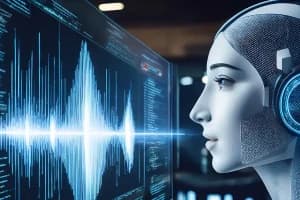In the world of data analysis and signal processing, Independent Component Analysis (ICA) stands as a powerful technique for separating mixed signals into their original sources. While it shares some similarities with Principal Component Analysis (PCA), ICA serves a fundamentally different purpose: rather than compressing information, it separates and isolates independent sources from mixed observations.
The Cocktail Party Problem
Understanding the Classic Scenario
The most intuitive way to understand ICA is through the famous cocktail party problem. Imagine two people having a conversation at a cocktail party, and you've positioned two microphones near these speakers. Each microphone will naturally pick up audio from both speakers, but with different intensities based on proximity.
The purple microphone, positioned closer to the blue speaker, captures more of that speaker's voice relative to the red speaker. Conversely, the pink microphone picks up more audio from the red speaker than the blue speaker. This creates a challenge: how can we take these mixed audio recordings and separate them back into individual audio files, each containing only one speaker's voice?
The ICA Solution
This is precisely where Independent Component Analysis excels. ICA transforms a set of mixed signals into a maximally independent set of components. In our cocktail party example, it takes the purple and pink audio signals (the measured recordings) and translates them back to the original sources: the speech from the blue speaker and the speech from the red speaker, respectively.
Key Assumptions of ICA
Statistical Independence
For ICA to work effectively, it relies on two critical assumptions. The first assumption is that the independent components must be statistically independent. In statistical terms, this means the joint distribution of two variables x and y equals the probability distribution of x multiplied by the probability of y. This independence is what allows the algorithm to distinguish between different sources.
Non-Gaussian Distribution
The second key assumption might seem counterintuitive to those familiar with traditional statistical analysis: the independent components must be non-Gaussian. While Gaussian distributions are beloved in statistics and science for their mathematical convenience, ICA actually requires non-Gaussian components to function properly. This non-Gaussianity is what makes the separation possible.
The Mathematical Framework
From Measured Signals to Independent Components
The mathematical relationship in ICA can be understood in two directions. First, we can think of our measured signals (like the microphone recordings) as combinations of independent components. The independent components, often called sources, are combined in some way to generate what we measure at our recording devices.
We can represent measured signals as x1 and x2, and the independent components or sources as s1 and s2. Importantly, this relationship can be reversed: we can combine our measured signals to express the independent components. If we can find the right linear combination of measured signals to derive independent components, then the set of values defined by a matrix w is all we need to perform ICA.
The Optimization Goal
Mathematically, the goal of ICA is straightforward yet powerful: given measured signals or data x, we want to solve for the matrix w such that the set of independent components are maximally independent. This concept of maximal independence can be quantified in two ways:
- Minimizing the mutual information between all independent components
- Maximizing the non-Gaussianity of the independent components
PCA vs. ICA: Understanding the Differences
Different Goals, Different Outcomes
While PCA and ICA are similar techniques in many ways, they are fundamentally distinct approaches with different objectives. PCA typically compresses information. When dealing with highly correlated variables, like hot dogs and hot dog buns, PCA can represent that information with fewer variables, reducing two correlated variables into a single component.
On the other hand, ICA separates information. It takes mixed variables, such as audio picked up by two microphones placed near two speakers, and separates out the independent components or sources that drive those measured signals. The goals are different, and so are the final outcomes.
The Importance of Auto Scaling
One important commonality between PCA and ICA is the critical preprocessing step of auto scaling. For each variable, you must subtract the variable's average and divide each element by its standard deviation. This is one reason why it's often advantageous to apply PCA to your dataset before applying ICA: all the preprocessing is already handled.
PCA will group correlated variables together, and then ICA can come in and separate out the independent drivers where applicable. This two-step approach often yields the best results in complex signal processing tasks.
Real-World Application: EEG Signal Processing
The Challenge of EEG Data
A concrete example of ICA's power comes from electroencephalography (EEG) research. EEG is a technique for measuring brain activity by placing electrodes on the head. While EEG offers excellent temporal resolution and is non-invasive, allowing people to move around while wearing the cap, it has a fundamental weakness.
Because the electrical signals from the brain are extremely weak, EEG must be highly sensitive to voltage fluctuations. This sensitivity makes it prone to artifacts: perturbations or oscillations in the signal that don't come from brain activity. These artifacts can include:
- Eye blinks
- Motion artifacts
- Talking
- Various types of environmental noise
Identifying Blink Artifacts
Consider the FP1 electrode, which sits near the front of the head on the left forehead. This electrode is particularly susceptible to blink artifacts because it's one of the closest electrodes to the eye. When plotting voltage versus time for this electrode, giant spikes in the signal clearly indicate when blinks occur. Since we're trying to measure brain activity rather than blink activity, these artifacts need to be removed.
The Two-Step Solution
The solution involves both PCA and ICA working together. Starting with 64 electrodes on an EEG cap (translating to 64 variables), PCA is first applied to reduce dimensionality from 64 variables to just 21 principal components, while maintaining 99.5 percent of the explained variation.
In MATLAB, this can be accomplished in a single line of code, as the PCA function automatically handles auto scaling. The same can be achieved in a few lines using Python's scikit-learn library.
Applying ICA to Remove Artifacts
Once PCA has reduced the dimensionality, ICA is applied to the 21 principal components to separate out the independent components. By plotting all the independent components and examining them visually, certain components stand out as reminiscent of blink artifacts. By squaring the independent components to make all values positive, the blink artifacts become even more prominent.
Using a simple heuristic of identifying components with four prominent peaks, specific independent components can be identified as corresponding to blinks. These blink-related components can then be dropped from the analysis, as they contain blink information rather than brain activity.
Reconstructing Clean Signals
After removing the artifact components, the process works backwards. The score matrix (the output of PCA) is reconstructed without the blink components, and then the original 64 variables are reconstructed by reversing the PCA transformation. The result is dramatic: electrodes that previously showed four prominent peaks corresponding to blinks now display clean signals with those artifacts removed.
Conclusion
Independent Component Analysis represents a powerful tool in the signal processing arsenal, particularly valuable when dealing with mixed signals that need to be separated into their constituent sources. While the cocktail party problem provides an intuitive introduction to the concept, ICA's applications extend far beyond audio processing.
The technique's utility in EEG signal processing demonstrates its practical value in neuroscience research, where separating brain signals from artifacts is crucial for accurate analysis. By understanding the fundamental assumptions of statistical independence and non-Gaussianity, and by leveraging the complementary strengths of PCA and ICA, researchers and data scientists can tackle complex signal separation challenges across diverse fields.
Whether you're processing audio signals, analyzing brain activity, or working with any mixed signal data, ICA offers a mathematically rigorous and practically effective approach to uncovering the independent sources hidden within your measurements.







